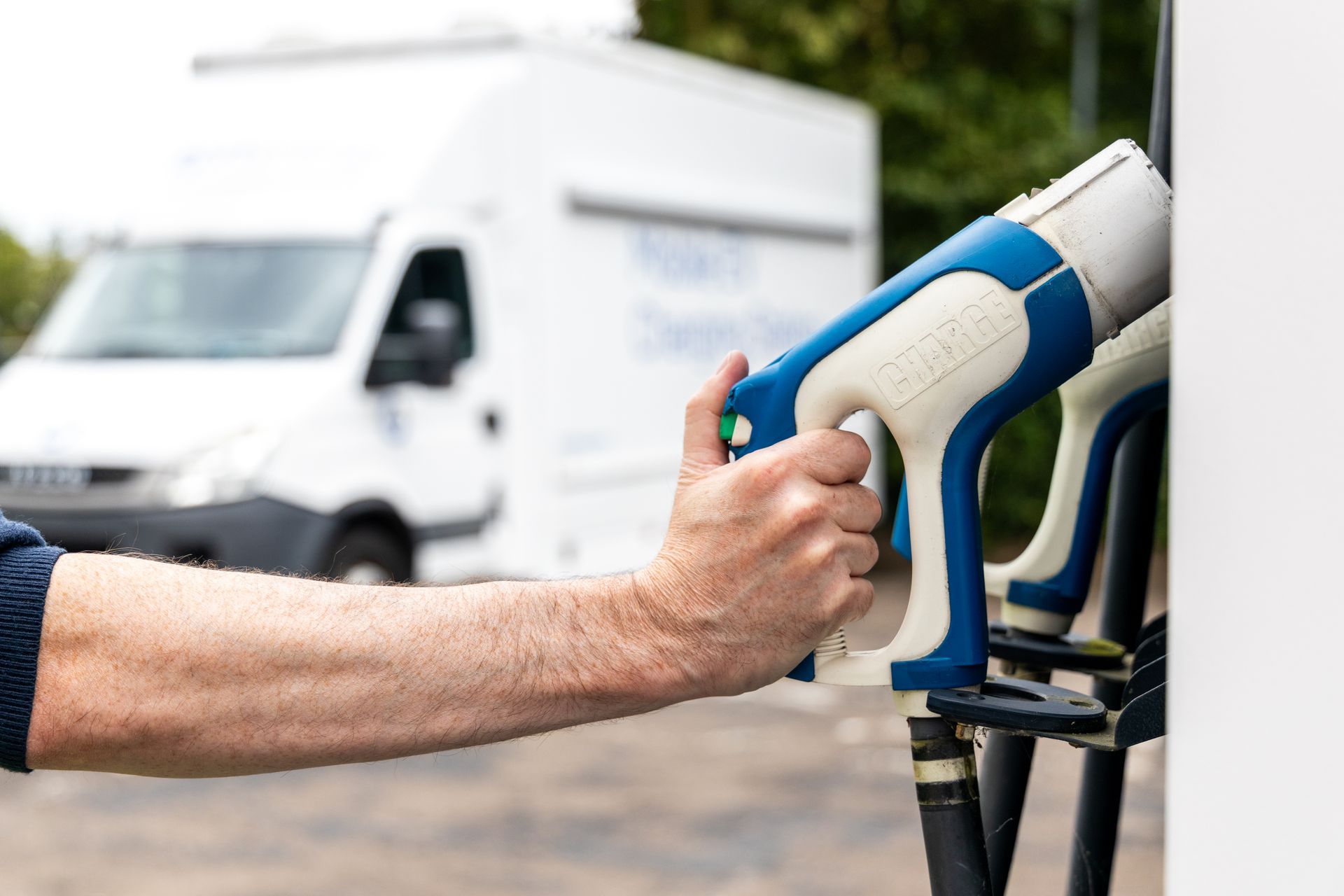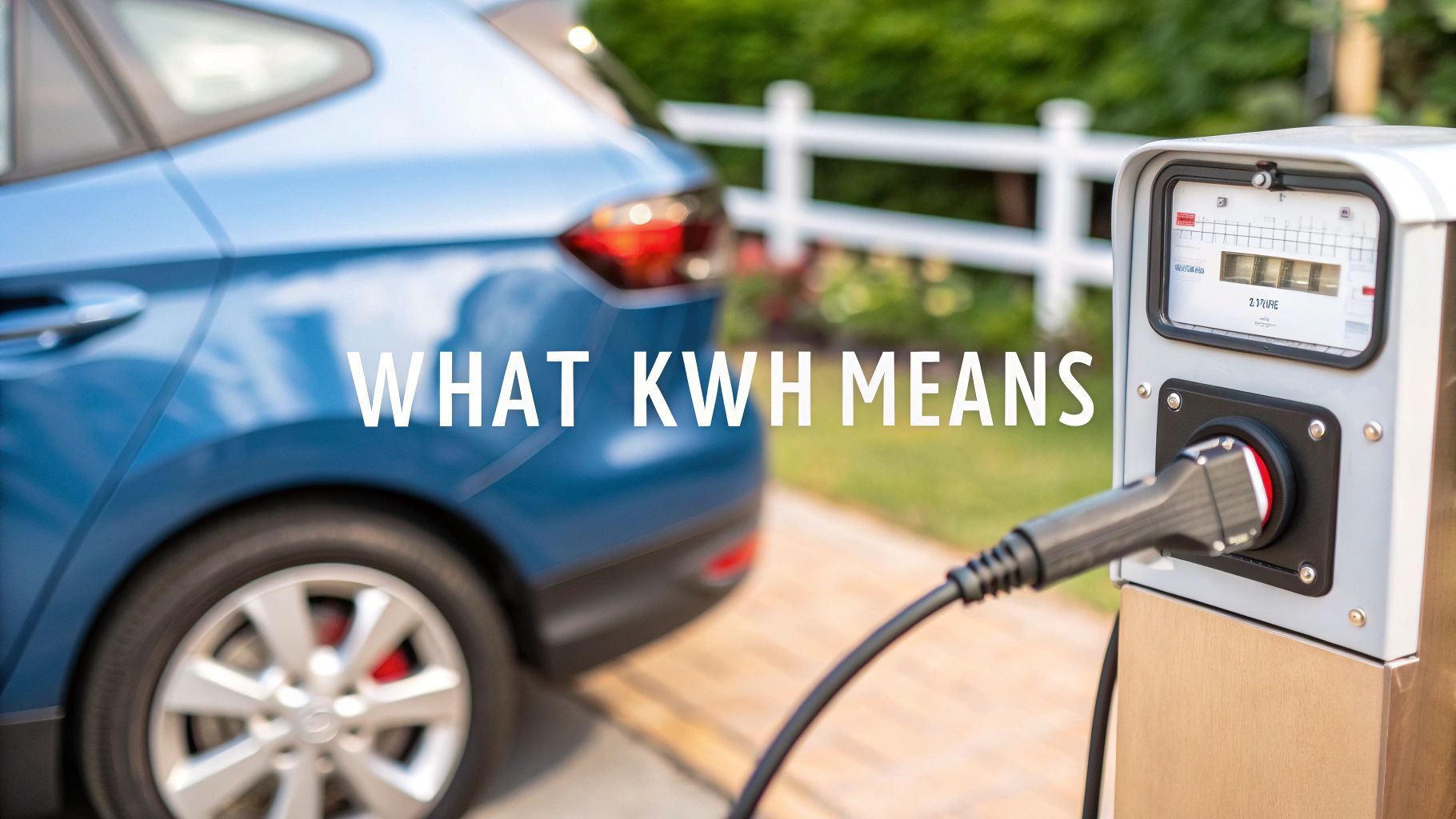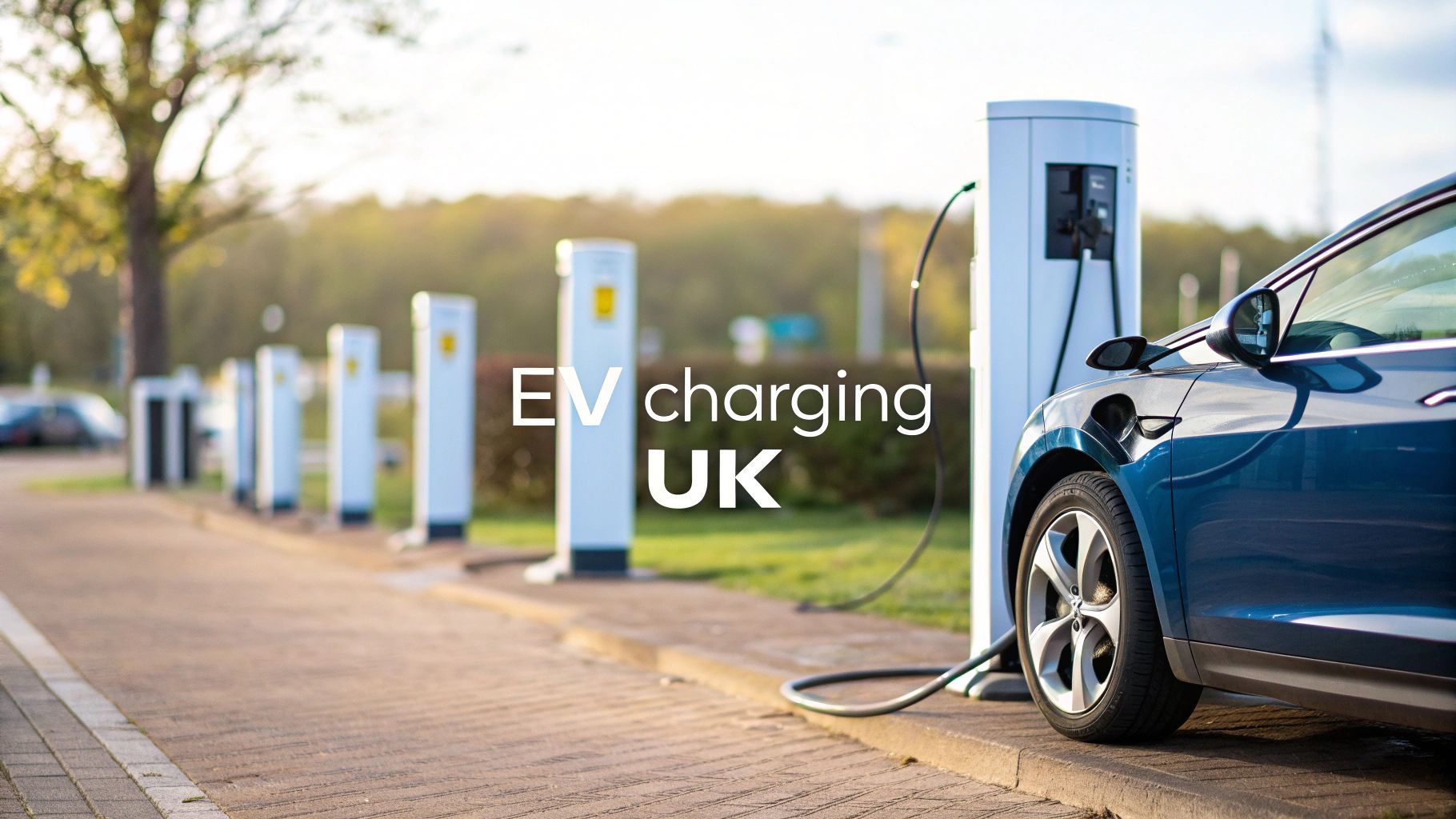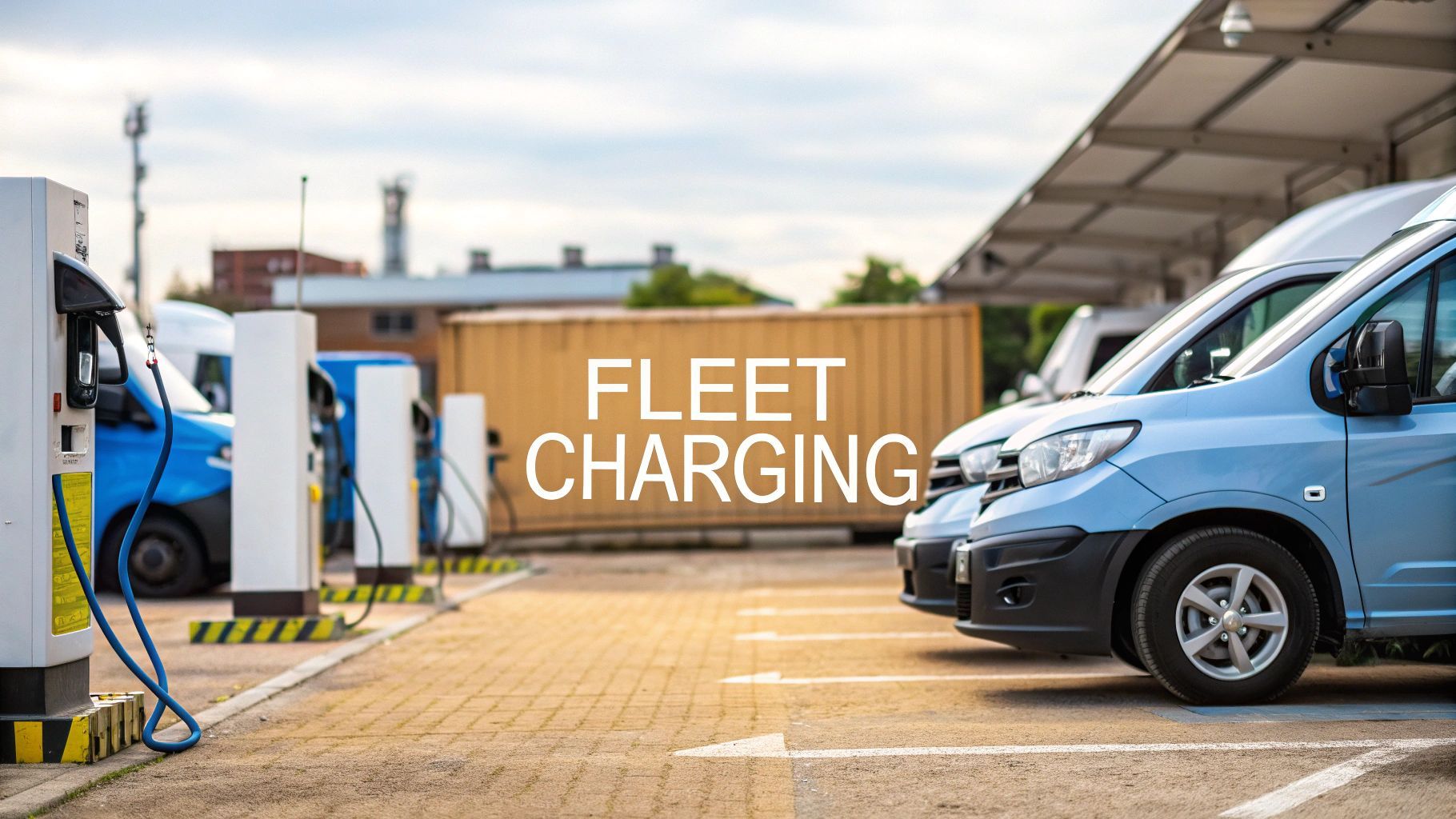How Does a Supercharger Work Explained
At its core, a supercharger is an air compressor designed to cram more oxygen into an engine’s cylinders, dramatically boosting its power output. This whole process is known as forced induction , and it allows the engine to burn more fuel, creating a much more potent explosion in the combustion chamber. The result? A serious jump in horsepower and torque.
What a Supercharger Does for Your Engine
Think of a standard engine like a jogger breathing normally. It just pulls in air at whatever the atmospheric pressure is. A supercharger, on the other hand, acts like a massive set of lungs, force-feeding the engine a much denser charge of air than it could ever manage on its own.
This is the secret to how a supercharger unlocks so much extra performance. More air means more oxygen molecules are packed into each cylinder. The fuel system then injects a matching amount of fuel to keep the air-fuel mix just right for a clean, powerful burn.
When that richer mixture ignites, the explosion is far more violent, pushing the pistons down with much greater force. This translates directly into more twisting power at the crankshaft and ultimately more grunt at the wheels. It's this simple but brutally effective principle that gives supercharged cars their famous, instantaneous throttle response.
The Core of Forced Induction
The term forced induction perfectly sums up the entire operation. A standard engine relies on the vacuum created by a piston’s downstroke to passively suck air in—a process called natural aspiration. A supercharger completely changes the game by actively pressurising the air before it even gets to the engine. This pressurised air is what we call 'boost'.
This one change completely transforms an engine's character. A typical supercharger can deliver a power increase of 30% to 50% over a standard engine, turning an everyday car into a high-performance machine without needing to swap in a bigger, heavier engine.
The real magic of a supercharger is how it delivers that boost instantly, right across the rev range. Because it's mechanically tied to the engine via a belt, its speed increases in perfect sync with the engine's speed, so there's absolutely no delay or 'lag'.
Understanding the Terminology
As we get further into the weeds, you'll come across a lot of specific terms. The world of performance tuning has its own language and getting a handle on the key phrases makes everything much clearer. For anyone new to this, our comprehensive EV charging glossary is a great resource for getting up to speed on related technical terms.
With this foundation in place—forcing more air and fuel into an engine—we can now look at the mechanical side of things. The next piece of the puzzle is understanding exactly how the supercharger gets its power to do all this work.
The Mechanical Heartbeat of a Supercharger
So, what makes a supercharger tick? Unlike a turbo that cleverly recycles exhaust gases, a supercharger is physically bolted and belted to the engine itself. It's a direct, mechanical link—the secret sauce behind its famous instant kick. This tether to the engine’s core is what defines it.
The connection is usually made with a heavy-duty belt, often the engine’s main serpentine belt . This belt snakes around a pulley on the engine's crankshaft and another on the supercharger. The crankshaft is the powerhouse of the engine, converting the violent up-and-down motion of the pistons into the spinning force that moves your car. By looping a belt around it, the engine’s own rotation is harnessed to spin the supercharger.
It’s a brilliantly simple and brutally effective setup. Think of it like the chain on a bicycle: the effort from your legs goes straight to the back wheel, making it turn instantly. In the same way, as the engine revs up, the belt spins faster, forcing the supercharger's compressor to whirl at mind-boggling speeds. This direct relationship is precisely why there’s no lag.
Proportional Power, Instant Punch
Because the supercharger is driven directly by the crankshaft, its speed is always perfectly in sync with the engine's. If the engine is ticking over at 800 RPM , the supercharger is spinning at a correspondingly relaxed pace. But the second you plant your foot and the engine screams to 4,000 RPM , the supercharger instantly matches its pace.
This seamless synchronisation means boost is always on tap, right across the rev range. You don’t have to wait for anything to build up; the power is there the moment you demand it. It’s why supercharged cars are loved for their razor-sharp throttle response and a beautifully linear power delivery that feels like a much bigger, naturally aspirated engine.
The mechanical link creates a one-to-one relationship between engine speed and supercharger speed. This direct drive is the fundamental reason superchargers deliver instant boost, sidestepping the delay or 'lag' sometimes found in other systems.
The Cost of Doing Business: Parasitic Loss
Of course, nothing is free. Spinning that supercharger takes energy and that energy has to come from somewhere. The power it siphons from the crankshaft is known as parasitic loss . In short, the engine has to give up a tiny bit of its own power just to turn the compressor.
At first, that sounds like a raw deal—robbing Peter to pay Paul. But the reality is that the power the supercharger consumes is a drop in the ocean compared to the monumental power it helps the engine create.
Here’s how that trade-off works in the real world:
- Power Consumed: A typical supercharger might need 20 to 40 horsepower just to run at full chat.
- Power Gained: But in return, that same unit could help the engine pump out an extra 150 horsepower or more .
- The Net Gain: The performance increase is massive, making the initial drag completely worthwhile.
This trade-off is central to how superchargers operate. While it borrows a little engine power to get going, the huge volume of pressurised air it shoves into the cylinders creates a much bigger, more potent bang. The result is a colossal net increase in horsepower and torque, making the parasitic loss a fantastic investment for anyone chasing performance.
Now that we've covered the mechanical link, it's time to peek inside the unit itself.
Exploring the Main Types of Supercharger
Not all superchargers are created equal. While they all do the same basic job—forcing more air into an engine—their internal designs completely change how they build and deliver that power. Understanding these differences is the key to knowing how a supercharger really works and why certain cars use specific types.
It’s a bit like choosing the right tool. You wouldn't use a sledgehammer to tap in a nail and you wouldn't use a small hammer to break down a wall. In the same way, the three main types of supercharger— Roots-type , Twin-Screw and Centrifugal —each have their own unique character, suited for very different performance goals.
This infographic shows the simple, direct power source that all mechanically driven superchargers share. Power flows straight from the engine's crankshaft, through a belt and into the supercharger itself.
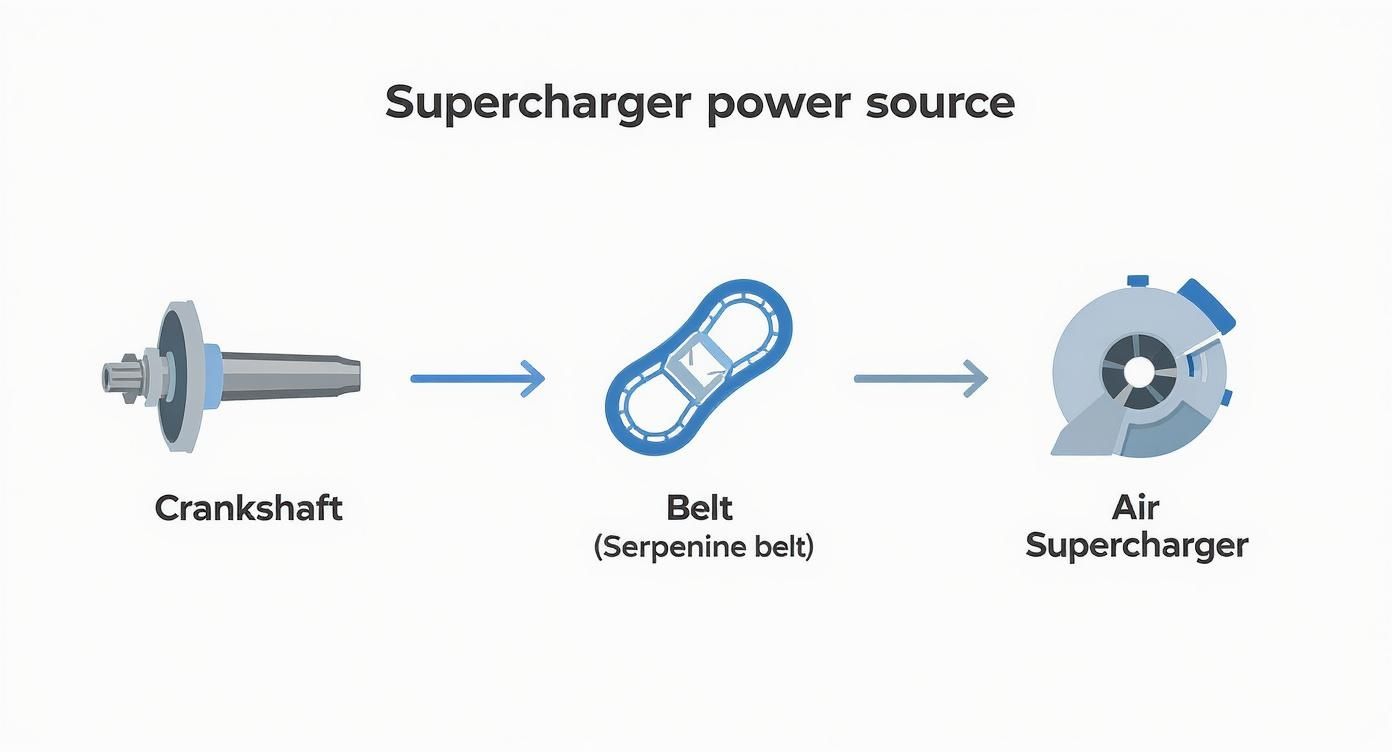
This direct mechanical link is what gives a supercharger its legendary instant response, as its speed is always directly tied to the engine's speed.
Roots-Type: The Original Powerhouse
The Roots-type supercharger is the oldest and maybe the most iconic design out there. It's the classic powerhouse you see sitting proudly on top of old-school American muscle car engines. Its mechanism is beautifully simple: inside the case, two interlocking lobes, shaped a bit like long gears, spin in opposite directions.
These lobes don't actually compress the air inside the unit. Instead, they work like a high-speed pump, grabbing pockets of air and shoving massive volumes of it into the engine’s intake. The pressure—the 'boost'—only builds up downstream as this air piles up faster than the engine can swallow it.
This design is brilliant at moving huge amounts of air, even at very low engine speeds. The result? A massive, instant kick of torque right from idle, giving a car that brutal, tyre-shredding launch that muscle cars are famous for. The trade-off is that they can be less efficient at higher RPMs and tend to generate a lot more heat than other designs.
Twin-Screw: The Efficient Compressor
At a quick glance, a twin-screw supercharger looks a lot like a Roots-type. It also uses two meshing rotors but their design is far more complex and clever. These are helical, screw-shaped rotors that interlock with incredibly tight tolerances.
This small difference changes everything. As the rotors spin, they pull air in from one end and progressively squeeze it into a smaller and smaller space as it travels down their length. This means the air is actually compressed inside the supercharger casing before it even gets to the engine.
The internal compression of a twin-screw supercharger makes it much more thermally efficient than a Roots-type. It delivers a cooler, denser charge of air, which allows for more power and greater reliability.
This efficiency, combined with its ability to produce strong boost right across the rev range, makes the twin-screw a popular choice for modern high-performance vehicles where you want both low-end grunt and high-end power.
Centrifugal: The High-RPM Specialist
A centrifugal supercharger works on a completely different principle, one that's closer to a turbocharger or even a jet engine. It uses a small, high-speed impeller—which looks like a fan—to suck air into the centre of its housing.
As this impeller spins at incredible speeds (often over 50,000 RPM ), centrifugal force flings the air outwards into a snail-shaped casing called a volute. This process massively increases the air's speed and as it slows down in the widening housing, its pressure skyrockets.
Unlike the other two types, a centrifugal supercharger's boost isn't linear. It builds exponentially with engine speed. This means it gives you a gentle push at low revs but then delivers a powerful, escalating surge of power as you climb towards the redline. This character makes it perfect for track cars and racing, where sustained high-RPM performance is everything.
Each of these designs offers a distinct approach to boosting an engine's performance. The choice between them often comes down to the desired power delivery and a vehicle's primary use. Here’s a quick breakdown to compare them side-by-side.
Comparison of Supercharger Types
| Feature | Roots-Type | Twin-Screw | Centrifugal |
|---|---|---|---|
| Power Delivery | Instant, massive torque at low RPM. | Strong, linear boost across the entire rev range. | Boost builds with RPM, strongest at high speeds. |
| Operating Principle | Pushes air in pockets (external compression). | Compresses air internally between helical rotors. | Uses an impeller and centrifugal force. |
| Efficiency | Least efficient, generates significant heat. | More efficient than Roots, cooler air charge. | Most efficient, especially at high RPM. |
| Best For | Classic muscle cars, drag racing, instant response. | Modern performance cars, street driving, all-round power. | Track cars, racing, high-RPM power builds. |
| Sound | Distinctive, high-pitched whine. | A more refined, smoother whine. | A subtle whistle that builds to a high-pitched sound. |
Ultimately, whether you're after the raw, immediate punch of a Roots-type or the top-end rush of a centrifugal unit, there's a supercharger designed to deliver the kind of performance you're looking for.
The market for these power-adders, including both mechanical superchargers and their electric cousins, is seeing steady growth in the UK and globally. This is driven by a constant demand for better engine performance and fuel efficiency. Projections for the UK show the supercharger market is set to grow at a compound annual growth rate (CAGR) of around 5.5% between 2025 and 2030. The centrifugal supercharger segment continues to be the largest revenue contributor, showing how important it is for improving engine efficiency. This isn't just for traditional petrol engines; they are also being integrated into hybrid vehicles to help meet tougher emissions rules. You can find more insights on the global automotive supercharger market on marketsandmarkets.com.
Why Cooling the Pressurised Air Is Crucial

Forcing more air into an engine is only half the battle. One of the fundamental laws of physics tells us that when you compress a gas, its temperature skyrockets. A supercharger, by its very nature, is a compressor—it squeezes air molecules together and this process generates a huge amount of heat.
This heated air creates a serious problem for both performance and reliability. Hot air is far less dense than cool air, meaning it contains fewer oxygen molecules in the same amount of space. Pushing hot, thin air into an engine is completely counterproductive; it undermines the entire reason for adding a supercharger in the first place.
Worse still, hot intake air dramatically increases the risk of a destructive phenomenon called engine knock , or detonation. This is where the air-fuel mixture ignites prematurely and violently, creating a damaging shockwave inside the cylinder instead of a smooth, controlled burn.
The Intercooler: An Engine's Refrigerator
This is where a critical component, the intercooler , comes into play. Think of an intercooler as a radiator, but for the pressurised air instead of the engine's coolant. Its sole job is to cool the hot, compressed air after it leaves the supercharger but before it enters the engine.
After being heated by the supercharger, the air is channelled through the intercooler's network of fins and tubes. As cooler ambient air flows over these fins—often thanks to its position at the front of the car—it draws heat away from the intake charge. This simple heat exchange can slash the air temperature.
An intercooler is not an optional extra; it is a vital safety and performance device in any modern supercharged system. By delivering a cooler, denser and more stable air charge, it allows the engine to make more power safely and reliably.
The result is a cooler, much denser charge of air flowing into the engine's cylinders. This dense air is packed with oxygen, allowing the engine to burn more fuel efficiently and generate significantly more power. Just as importantly, it keeps combustion temperatures stable, preventing engine knock.
Understanding Boost Pressure
Alongside heat, the other key variable in any supercharger system is pressure. The amount of pressure a supercharger creates above normal atmospheric pressure is known as boost pressure . It’s the metric we use to measure just how much extra air is being forced into the engine.
Boost pressure is typically measured in pounds per square inch (PSI) or Bar. For example, a supercharger producing 8 PSI of boost is forcing air into the engine at a pressure 8 PSI higher than the surrounding atmosphere. This figure is crucial because it directly correlates to the potential power gain.
A higher boost level means a greater volume of air is being crammed into the cylinders, enabling a bigger, more powerful combustion event. However, running higher boost also generates more heat and places much greater stress on the engine's internal components.
Balancing Heat and Pressure for Optimal Power
Achieving safe, reliable power from a supercharged engine is a delicate balancing act between managing boost pressure and controlling intake temperatures. Pushing for high boost levels without an effective intercooler is a recipe for disaster. The resulting high temperatures will almost certainly lead to engine damage.
Here’s how these two factors work together to unlock a supercharger's full potential:
- Boost Pressure: This determines the quantity of air being forced into the engine. More boost equals more potential power.
- Intake Temperature: This determines the quality and density of that air. Lower temperatures mean denser, safer and more powerful air.
Professional engine tuners spend countless hours optimising this relationship. They carefully calibrate the fuel and ignition timing to match the characteristics of the cooler, denser air provided by the intercooler. This meticulous tuning ensures the engine can handle the increased cylinder pressures created by the boost, delivering a smooth, powerful and reliable driving experience.
Ultimately, the intercooler is what makes modern, high-boost supercharging both possible and safe.
The Dawn of the Electric Supercharger
While mechanically driven superchargers are the classic way to force more air into an engine, the industry has been busy cooking up a smarter, more nimble evolution. The electric supercharger represents a huge leap forward, neatly solving the biggest drawbacks of its belt-driven ancestors and becoming a cornerstone of modern engine design.
Unlike a traditional unit physically bolted to the engine's crankshaft, an electric supercharger runs on its own high-speed electric motor. This clever bit of engineering completely decouples it from engine revs, giving it the freedom to deliver boost precisely when it’s needed most, all without draining power from the engine itself.
This setup is an absolute game-changer for eliminating lag. Because it isn’t waiting for the engine to spin up, an electric supercharger can spool its compressor to incredible speeds almost instantly. The result? A powerful punch of pressurised air right from idle, filling in the torque gaps where traditional turbochargers notoriously struggle.
The Perfect Partner for Hybrid Technology
Electric superchargers have truly found their home in today’s hybrid vehicles. In these advanced powertrains, they act as the perfect bridge, seamlessly blending the performance of the petrol engine with the instant torque of the electric motor. It’s all about creating one smooth, uninterrupted wave of acceleration.
This technology has quickly become a vital tool for car manufacturers. It allows them to downsize engines for better fuel economy while still delivering the snappy, responsive performance drivers have come to expect. With an electric supercharger, a smaller engine can feel just as potent as a much larger one.
The electric supercharger’s ability to work independently of engine speed makes it a perfect solution for modern hybrid systems. It delivers on-demand boost to create a completely seamless driving experience, smoothing out the transition between electric and petrol power.
The growing use of this technology is happening right across the automotive world. As electric superchargers become more common, it's worth taking a step back to look at the bigger picture and the overall pros and cons of electric vehicles .
Market Growth and Future Potential
The big push towards electrification is fuelling some serious growth in this area. The global electric supercharger market is projected to expand massively, from USD 22.45 billion in 2025 to around USD 71.85 billion by 2034. That’s a compound annual growth rate of about 13.8% .
This trend is running in lockstep with UK government initiatives aimed at supporting hybrid technology to slash CO2 emissions. You can dig deeper into the growth of the electric supercharger market at precedenceresearch.com. This momentum is also helped by the ever-increasing number of hybrid models hitting UK roads and the expansion of the charging network.
A massive plus for electric superchargers is their efficiency—they only draw power when they're actually needed. If you're curious about the nuts and bolts of electrical power measurement, you can check out our guide on how to calculate a kilowatt-hour .
As the automotive world continues its journey towards full electrification, the electric supercharger stands out as a critical bridging technology, making today's engines both more powerful and more efficient.
Frequently Asked Questions About Superchargers
We've explored the mechanics, designs and cooling systems behind superchargers. Now, let’s get into the questions that pop up most often. Understanding these practical points helps paint a complete picture of what owning and running a supercharged car is really like in the real world.
What Is the Difference Between a Supercharger and a Turbocharger?
The biggest difference is how they’re powered. A supercharger is driven by a belt connected directly to the engine's crankshaft, which means it’s always spinning in proportion to your engine speed. The result? Instant power, right from low revs, with absolutely no lag.
A turbocharger, on the other hand, runs off the engine’s waste exhaust gases. An exhaust turbine spins an intake turbine, forcing air into the engine. While this is a clever way to recycle energy, it takes a moment for the exhaust flow to build enough pressure to create a noticeable boost. This delay is what’s known as 'turbo lag'.
So, in short: superchargers give you immediate, linear power, while turbochargers offer efficient power by using energy that would otherwise go to waste.
Can Adding a Supercharger Damage My Engine?
If it's a quality kit installed and tuned by a professional, it’s designed to work safely within your engine’s original limits. But it's crucial to remember that forcing more power out of an engine naturally adds more stress to its internal parts—things like pistons, connecting rods and bearings.
Trying to run very high boost levels without upgrading these components is asking for trouble and can definitely lead to premature wear or, worse, catastrophic failure.
A professional installation and a conservative, reliable engine tune are absolutely vital for long-term engine health. The goal is to enhance performance without compromising the engine's durability, creating a powerful yet dependable vehicle.
If you’re thinking about a supercharger upgrade, it’s worth researching the best aftermarket car parts brands to make sure all the supporting mods can handle the extra grunt.
How Much Power Does a Supercharger Add?
That’s a bit like asking how long a piece of string is! The power gain varies massively depending on the engine, the type of supercharger and how much boost pressure it's set to produce.
As a general rule, a typical road car with a professionally fitted aftermarket kit can see a horsepower increase of anywhere from 30% to over 50% . On highly modified performance engines—built from the ground up to handle forced induction—the gains can be far more dramatic, often more than doubling the original factory output.
Will a Supercharger Make My Car Less Fuel Efficient?
Yes, generally speaking, fitting a supercharger will hurt your fuel economy. It’s designed to help the engine burn more fuel to make more power, so higher consumption is part of the deal. The supercharger itself also uses a small amount of engine power just to operate—a phenomenon known as parasitic loss—which chips away at efficiency too.
When you’re driving gently or cruising on the motorway, the impact can be pretty minimal. The moment you put your foot down to use that extra power, though, the engine will be drinking significantly more fuel than it did in its standard, naturally aspirated form.
Are Superchargers and Supercharging the Same Thing?
This is a really common point of confusion, especially now with so many electric cars on the road. The short answer is no—they are completely different things.
- A supercharger is a mechanical air pump that forces more air into a petrol or diesel engine to increase its power. It's a piece of hardware bolted to the engine.
- Supercharging is the term Tesla popularised for its network of high-speed DC fast chargers for electric vehicles. It refers to the process of rapidly recharging an EV's battery.
While they share a name, they apply to entirely different technologies for completely different types of vehicles. The cost and availability of EV charging are hot topics, and you can learn more about them in our detailed guide on the Tesla Supercharger cost in the UK . Getting this distinction right is key in today's evolving automotive world.
When your electric vehicle needs a charge on the go, whether due to an emergency or a lack of fixed infrastructure, ZAPME provides the solution. Our mobile EV charging units bring the power to you, eliminating range anxiety and keeping your fleet operational. Discover how our innovative Energy as a Service model can support your EV needs by visiting https://www.zapme.biz.

